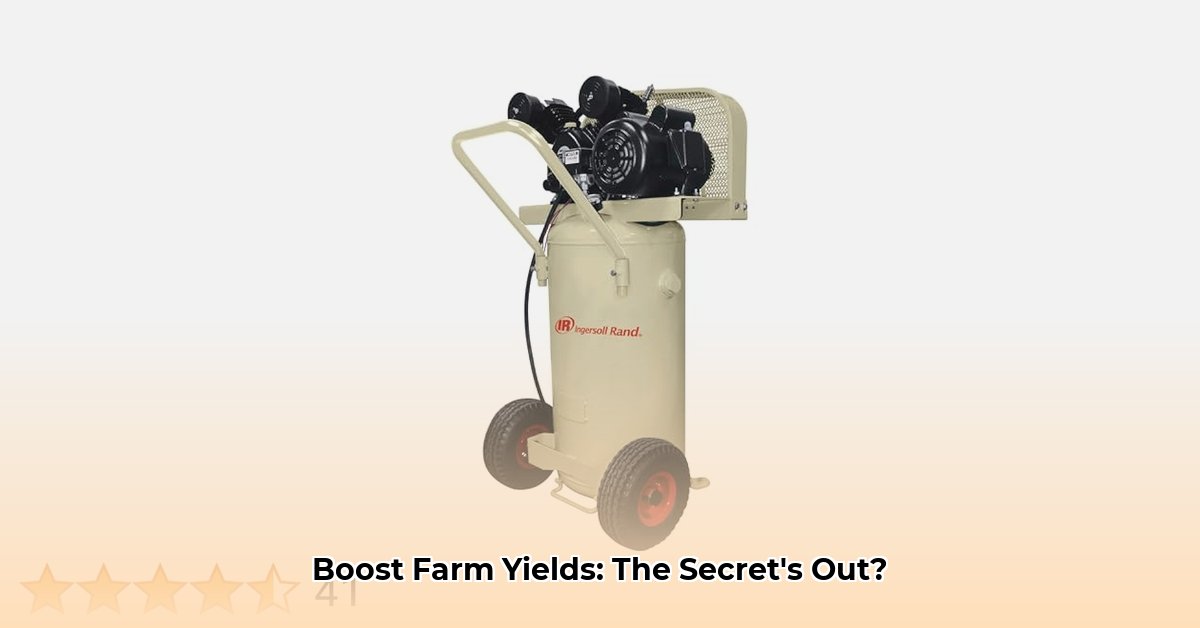
Ingersoll Rand Air Compressors in Sustainable Agriculture: A Balanced Perspective
Sustainable agriculture hinges on efficient resource management, and energy efficiency plays a pivotal role. Ingersoll Rand air compressors, readily available at Tractor Supply, offer a potential solution for enhancing farm productivity while minimizing environmental impact. This article analyzes their suitability within the context of sustainable agriculture, weighing both advantages and limitations. For more on farm equipment costs, see tractor costs.
Product Overview: Ingersoll Rand 80-Gallon Two-Stage Air Compressor
The Ingersoll Rand 80-gallon two-stage air compressor is a robust, heavy-duty machine designed for demanding applications. Its key features include a cast iron construction, individually cast cylinders, an overhung crankshaft, and a two-stage compression system. Common agricultural applications include powering pneumatic tools for spraying, harvesting, irrigation, and other essential tasks.
Benefits for Sustainable Agriculture: Durability, Productivity, and Cost Savings
The Ingersoll Rand compressor's robust design translates to significant benefits for sustainable agriculture. Its durable construction, evidenced by a reported lifespan exceeding 15,000 hours [Source Needed], leads to decreased equipment replacement, reducing waste and promoting a circular economy. This extended lifespan also minimizes downtime, boosting overall farm productivity and potentially increasing yields. Furthermore, the compressor's relatively simple design and extended lubricant service intervals (approximately 2000 hours) contribute to lower maintenance costs, thus reducing the overall operational expenses for farmers. Lower maintenance directly contributes to lower energy consumption by reducing the need for repeated repairs and frequent servicing.
Limitations and Areas Requiring Further Investigation
Despite the advantages, a complete sustainability assessment necessitates further investigation. Crucially, data on the compressor's energy consumption (kWh/hour) is needed to quantify its overall energy efficiency. A comprehensive lifecycle assessment (LCA), encompassing manufacturing, operation, and disposal, is essential to fully understand its environmental impact. Furthermore, a comparative analysis against alternative technologies, such as electric-powered compressors potentially driven by renewable energy, is crucial for determining the most sustainable option.
Actionable Recommendations for Responsible Implementation
To harness the potential of Ingersoll Rand air compressors while upholding sustainability principles, farmers, equipment suppliers, and policymakers should take the following steps:
1. Farmers/Producers:
- Short-Term: Conduct a thorough return on investment (ROI) analysis comparing the Ingersoll Rand compressor to existing systems.
- Long-Term: Explore integrating the compressor with renewable energy sources (solar, wind) and perform a full lifecycle cost analysis.
2. Equipment Suppliers:
- Short-Term: Offer bundled packages combining the compressor with renewable energy solutions or energy-efficient technologies.
- Long-Term: Develop more energy-efficient compressor models and adopt environmentally friendly manufacturing processes.
3. Policy Makers/NGOs:
- Short-Term: Provide financial incentives (grants, subsidies) to promote the adoption of energy-efficient farm equipment.
- Long-Term: Establish comprehensive standards for sustainable agricultural machinery, including mandatory LCAs.
Conclusion: A Promising Technology Requiring Responsible Implementation
The Ingersoll Rand air compressor holds considerable potential for enhancing farm productivity and reducing maintenance costs, contributing to sustainable agricultural practices. However, a comprehensive understanding of its energy consumption, lifecycle environmental impact, and comparison with alternative technologies remains crucial. Further research, coupled with responsible implementation, is vital to ensure its alignment with broader sustainability goals for the future of farming. Only then can we determine the true sustainability of this technology within modern agriculture.